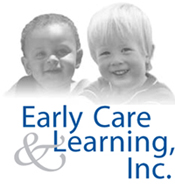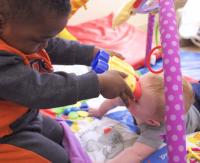Related Information and Research
Research in the field of early childhood care and learning point to the relationship between teacher and child as the most important influencer of program quality. If so, the longer the relationship, the more effective the outcomes for children. A child's personality is developed by interactions beween dependable, consistent, caring adults and the child over time.These relationships must have both depth and duration for children to reap optimum benefits and to receive the highest quality, value-added experiences.
The following publications,from well-established sources,support the benefits of using a system of primary care giving in mixed-age groupings for infants and toddlers:
- Bernhardt, Jennifer L. A Primary Caregiving System for Infants and Toddlers: Best for Everyone Involved,Young Children, March, 2000.
- Cryer, D. et al. The Effects of Transitions to New Child Care Centers on Infant/Toddler Distress and Behavior, Frank Porter Graham Child Development Institute, University of North Carolina at Chapel Hill, 2005.
- Elicker, James and Fortner-Woods, Cheryl. Adult-Child Relationships in Early Childhood Programs,Young Children, November, 1995.
- Goldstein, Anne, Hamm, Katie, and Schumacher, Rachel. Supporting Growth and Development of Babies in Child Care: What Does the Research Say? , Center for Law and Social Policy (CLASP) and Zero to Three Policy Center, June, 2007.
- Gray, Peter. The Special Value of Age-Mixed Play, American Journal of Play, Spring, 2011.
- Katz, Lillian. The Case for Mixed-age Grouping in Early Education, , National Association of Young Children, 1990. Also available on line: The Benefits of the Mix by Lillian Katz.
- Lally, J. Ronald (WestEd: Center for Child and Family Studies).The Science and Psychology of Infant-Toddler Care: How an Understanding of Early Learning has Transformed Child Care, Zero to Three, November, 2009.
- Lally, J. Ronald (West Ed: Center for Child and Family Studies). Infants have Their Own Curriculum: A Responsive Approach to Curriculum Planning for Infants and Toddlers, Head Start Bulletin, #67, March, 2000.
- Lally, J. Ronald (West-Ed: Center for Child and Family Studies). The Impact of Child Care Policies and Practices on Infant/Toddler Identity Formation, Young Children, November, 1995.
- Lally, J. Ronald, Ledon-Torres,Yolanda, and Phelps,Pamela C. Caring for Infants and Toddlers in Groups, Zero to Three, October, 2011. This article is based on earlier print and video materials of the Program for Infant/toddler Care (PITC).
- McGaha, Cindy, Cummings,Rebekkah, LIppard, Barbara & Dallas, Karen. Relationship Building: Infants,Toddlers and 2-Year-Olds,Early Childhood Research and Practice, Vol. 13, No.1, 2011.
- National Scientific Council on the Developing Child, 2007, Center on the Developing Child at Harvard University. This issue is devoted to understanding the effects of early experiences from birth on brain development and its implicaitons for subsequent learning, behavior and health.
- Parlakian, Rebecca and Seibel, Nancy. Building Strong Foundations: Practical Guidance for Promoting the Social-Emotional Development of Infants and Toddlers, Zero to Three, 2002.
- Schumacher, Rachel, Hamm, Katie, Goldstein, Ann and Lombardi, Joan. Starting Off Right: Promoting Child Development from Birth in State Early Care Initiatives,Center for Law and Social Policy (CLASP) and Zero to Three, July, 2006.
- Whatley, Kimberlee L. and Kantor, Rebecca. Mixed-age Grouping in Infant/toddler Child Care: Enhancing Developmental Processes, Child and Youth Care Forum, vol. 21, number 6, Dec. 1992.
- Continuity of Care in Early Head Start Group Setting, Early Head Start National Resource Center (EHSNRC),Tip Sheet No. 21, May, 2004.
- Resources on Infants and Toddlers:Providing Responsive and Supportive Care, Beyond the Journal, Young Children on the Web, July , 2006. NAEYC provides a list of relevant books, articles, and videos in addition to a list of web sites, programs and organizations, devoted to enhancing quality care for infants and toddlers.
* Young Children is a publication of NAEYC

